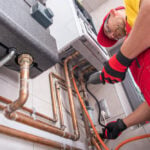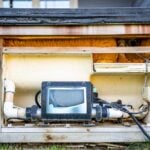
What Are the Signs of a Broken Sewer Pipe?
- By: Amer ZaghloulehUncategorizedComment: 0
A broken sewer pipe can be devastating for homeowners. These pipes are responsible for carrying waste from your home to the city’s sewage system.
Broken sewer pipes allow raw sewage to enter your home and contaminate everything inside of it. If you notice any of the following signs, please call a professional as soon as possible.
1. Strong sewer odor: This is the first sign that something might be wrong. A strong sewer odor means a pipe has likely broken or come apart somehow, and sewage is seeping into your home’s flooring, carpet, furniture, etc. This can cause health problems like skin rashes and damage to your belongings if not addressed quickly enough.
2. Toilet that gurgles: This one is a little trickier to spot. However, if you notice your toilet gurgling or making noises like bubbles popping, it may be because sewage has leaked into the pipes and caused debris to enter. The debris can cause clogs in your toilets, making them difficult to use.
3. Drains that take a long time to clear: Sewage seeping into your plumbing can cause debris to enter and clog up the drains. This makes it difficult for such drains to clear, meaning you’ll find water in places where there shouldn’t be any.
4. Regular sewage backup in the toilet or tub: A sewer backup is a sign of a broken sewer pipe. If there’s water in places that are connected to your plumbing, like your toilet or bathtub, and you’re not sure where it came from, then this may be the case.
5. Mold or mildew growing on your ceilings or walls: Mold can be caused by excess moisture or humidity. A broken sewer pipe will also lead to mold growing on your ceilings and walls (this usually happens if there is a floor above yours). It’s a sign that you need to call in professional help with this problem.
6. Walls are beginning to crack: A broken sewer pipe can also lead to cracks in your walls. This is because the weight of water builds up on one side, and when it seeps out, it causes pressure that creates these cracks.
7. Invasion of pests into the home: Since sewage pipes are dirty, you may be invaded by pests such as ants, roaches, or even rats. These animals will come to your home because of the excess moisture and sewage that is seeping out.
8. Greener-than-usual patches on your lawn: Your lawn may have green patches that are larger and more pronounced than before. This is due to the seeping of raw sewage from a broken sewer pipe.
9. Lawns or pavers that show indentations: As the pipe continues to crack, it will lead to indentations that form on your lawn or pavers. This is usually a result of increased surface tension.
10. Sewage pooling on your lawn: If you notice sewage pooling on your lawn, this is a sign of a broken sewer pipe. The excess water will cause the ground to be saturated and unable to absorb any more liquid.
Ways you can handle a broken sewer pipe
While it is important to know about the signs of a broken sewer pipe, it’s equally important to know how to handle one if you notice one.
1. Find the broken pipe: The first step is to find the pipe. This might be a difficult task, but if you’re lucky, it’ll only take you ten minutes or so. To find the pipe, you have to look for any pipe that is coming from the ground.
The best way to do this would be to dig up a small patch of your lawn or pavers and then look at the edges of it with a flashlight. You can also spray soapy water on your pipes, wait ten minutes, and see which areas suds up. If bubbles are appearing around one spot, then you’re good to go!
2. Evaluate the damage: The next thing is to evaluate the damage. For this, you’ll need to go inside your home and turn off all water valves that might be supplying water to such pipes. This can include toilets, sinks, showers, dishwashers – anything close enough to a sewer line should be shut down before continuing with any work on it.
Once all of these are turned off, you can see where the sewage has pooled up or is leaking into your house. It’s better not to ignore small problems when they come because if left untreated, they will only get worse over time!
3. Try to unclog the drain: Here, you should clean up any debris that’s on your way to the pipe. If you can’t see anything, use a plunger or bucket of water with some dish soap to break it down and make it easier for you to remove the clog yourself.
4. Call the professionals for help: The next step is to reach out to the experts when you cannot fix the problem on your own. You can call us at Anytime Plumbing. We’re always ready to help you out.







